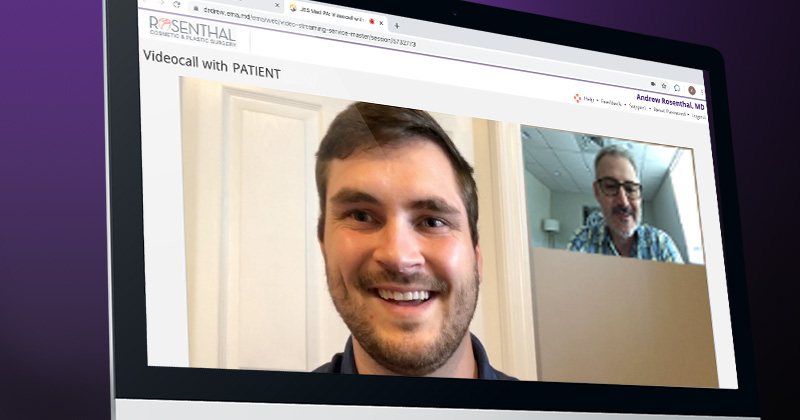Physician Q&A: Telehealth for Plastic Surgery

An interview with plastic surgeon Drew Rosenthal, MD
Every day, Modernizing Medicine® strives to help physicians. During this unprecedented time of crisis with the COVID-19 pandemic, our mission remains unchanged as we look for ways to help doctors see patients remotely to continue providing personalized care.
Our plastic surgery telehealth solution, modmed® Telehealth, helps physicians continue to care for and screen patients, even when their office is closed. To see how physicians can apply telemedicine in their practices, we interviewed Dr. Andrew Rosenthal about his experience with modmed Telehealth for plastic surgery.
Q: How has your office been using the modmed Telehealth solution?
A: We’re evaluating patients to see who needs to come in, and which can have their entire consults online through modmed Telehealth. We’re seeing follow-ups, which will be great even when we’re past this crisis. We can check on them virtually the next day after surgery, rather than have them come in. We’re also doing general evaluations. We have both dermatology and plastic surgery in the office, so we’re able to see the dermatology patients as well.
Q: What feature do you like best about the plastic surgery telehealth solution?
A: The video quality is great. I think people might ask, “Why can’t I just use some other video conferencing solution?” But the quality of the picture and the video of modmed Telehealth is better. We allow you to use the light with the back camera.
Q: Have there been any challenges?
A: I think the biggest challenge is trying to get some patients to input their information remotely. If they do it in the office, it’s easier to help them, but it’s a little more involved to explain it over the phone.
Q: How do patients feel about their plastic surgery telehealth experiences?
A: They’re thankful for the opportunity to use it. We’ve been doing virtual consults with other platforms for years. We see cosmetic patients from all over the nation, and even sometimes outside the US. Now we can do it with the EMR system, which we like better.
Q: How do you see other plastic surgery practices using modmed Telehealth in their practices?
A: I think that once the COVID-19 pandemic passes, plastic surgeons will continue to use it for cosmetic patients. We often answer questions for patients on the weekends or after hours, and we’ve done so for free. Telehealth should make it easier for practices that use this technology to bill for those services and our time.
Also, we frequently highlight that with telemedicine, the patient can be remote, but the doctor can be remote, too. If there’s a situation where a doctor can’t be in the office, the patient can still come in. We have tremendously talented staff who can do a lot of things for us, but they need our eyes and opinions, so telehealth can be used for that as well.
Q: How do you see telehealth for plastic surgery playing a role in the future of medicine?
A: I believe that this is a game-changer, and not only during this crisis. Telehealth will change how we practice medicine and how we interact with patients, and it will make us more efficient. It will be better for patients in many circumstances, too. In the future, we will continue to use these tools to be better care providers for our patients and enable them to access care much more easily and efficiently.
Q: Do you have any advice for other plastic surgery practices that might be wondering how they can keep seeing patients in the wake of COVID-19?
A: It’s important to learn how to use tools like telehealth for plastic surgery. Don’t think about how your practice is going to be in a week, think about where you’re going to be in a few months, and how these tools will help you in the future.
Before the COVID-19 crisis happened, physician burnout was a major concern, and now it seems even worse when you layer the current stresses on top of it. The best thing you can do is take care of yourself and take care of your family, and take care of your staff.
Disclosure: This blog is intended for informational purposes only and does not constitute legal or medical advice. Please consult with your legal counsel and other qualified advisors to ensure compliance with applicable laws, regulations, and standards. It is each provider’s responsibility to determine that any telemedicine visit meets medical necessity for a given patient. Not all clinical scenarios may be appropriate for telemedicine visits, and the provider may need to evaluate the patient in person to establish a diagnosis or initiate treatment.